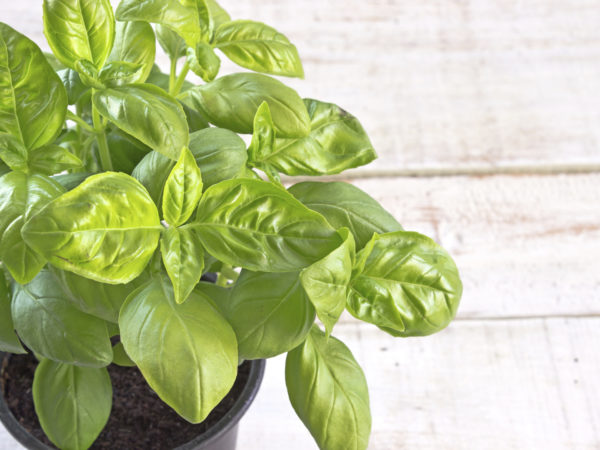Basil Basics

I’m going to speculate, and suggest that basil might be the most popular herb in the garden. Its sweet, aromatic leaves have both a distinct character and subtle flavor that comes through whether dried, cooked, frozen or fresh. Just a slight touch to the plant and it releases its refreshing scent into the air. My friend absent-mindedly runs her hands through her potted basil while she converses on her porch, pausing every so often to breathe deeply.
Though grasshoppers seem to like it, it is a trouble free plant to grow in a pot or in a sunny position in the garden. The real argument for growing your own basil is not how easy it is but the sheer number of varieties of basil that you can get if you start your own seed.
Basil, Ocimum species, is a great plant to grow in containers. It can be kept in a bright, warm windowsill in the kitchen for easy access. I start my seeds a couple of months before the last frost. Some are transplanted into the garden and others are planted in pots that I give away to my friends. When tomato plants go in the ground, I always sprinkle some basil seed nearby because they go so well together. The young tomatoes stay watered until they are well established and the excess water goes to the basil. Basil also likes to be protected from too much sun so the tomato plant shades the basil.
Though the seeds are easy to germinate, basil grows slowly in cooler temperatures. Once the long, warm days of summer hit its leaves, don’t be afraid to start harvesting enough to season your dishes. Growing it in organic potting soil in containers or a well-composted garden bed are its only requirements.
One mature, large-leafed plant provides enough basil for a couple batches of pesto. A half-dozen or so plants will bear enough for fresh use and drying. Pinching off the growing tip when the plant is six to eight inches tall will promote a bushier habit and increase the plant’s productivity. Pinching off the earliest flower buds can slightly prolong the usable life of your basil leaves, whose flavor is said to be most intense just before the white flowers open at its tip.
Inevitably, your plant will flower and go to seed. Collecting basil seed is one of my favorite garden chores. I know of no sweeter smell than that of the dry seed pods. In fact, the smell is so similar to that of Fruit Stripe gum that it sends me on an olfactory memory trip down the dimly lit aisles of the old A & P Supermarket.
There are several varieties of basil. Thirty to 40 varieties or more can be found commonly in various seed catalogues. New varieties emerge each year. Though the Italians once produced most of the new cultivars, recent interest in basil has caused the addition of newer varieties from places not traditionally associated with basil, like America. I generally grow a type of sweet basil, Ocicum basilicum, sold as Salad Leaf Basil. As the name implies, it has large, light green leaves and consistent good flavor throughout the season. Recent cultivars added to commonly available stock include lemon, lime, anise and cinnamon flavored basils. Thai, Siam, holy and purple basil are all very tasty, too. I’ve grown so many different basils that I now grow Salad Leaf for its productivity every year and other varieties to add depth and interest to the garden.
Though basil is mostly used as a seasoning, it has a rich medicinal history. It is said to work well as a digestive aid and a sedative, as well as for the treatment of headaches and migraines. Chinese medicine employs basil to treat intestinal, kidney and circulatory problems. It has also been used as an antiseptic. Though it contains vitamins and minerals, its traditional medicinal role and its most common use as a flavoring mean that it will only provide modest amounts of potassium, calcium, vitamin C, iron, phosphorus, magnesium and vitamin A on a per-serving basis.
Basil can also serve as a lesson in the need for gentleness in life. “I pray your Highness mark this curious herb: Touch it but lightly, stroke it softly, Sir, And it gives forth an odor sweet and rare; But crush it harshly and you’ll make a scent Most disagreeable,” pointed out 19th-century folklorist Charles Godfrey Leland. If basil can teach us all to touch rather than crush, it will have earned an honored position in any garden.
By Jace Mortensen, Guest Commentator
DrWeil.com News












